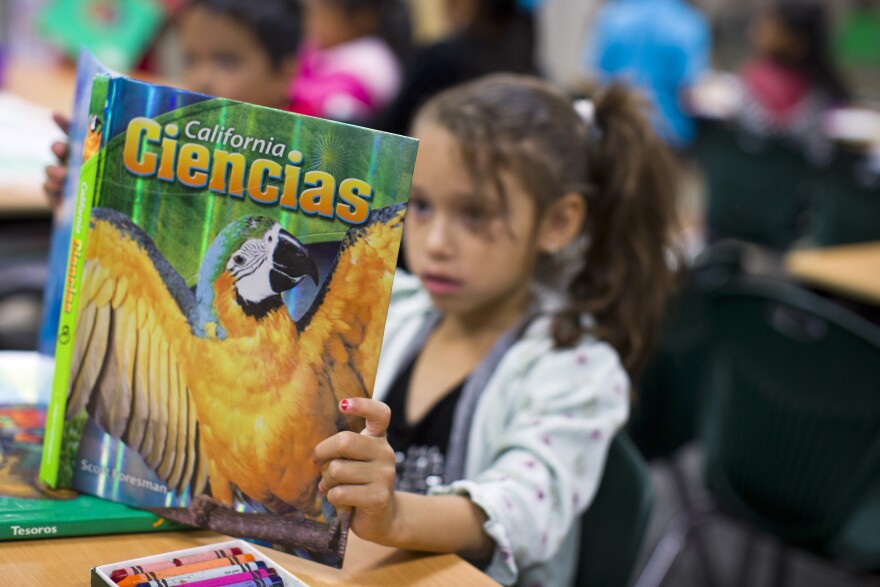Truth matters. Community matters. Your support makes both possible. LAist is one of the few places where news remains independent and free from political and corporate influence. Stand up for truth and for LAist. Make your year-end tax-deductible gift now.
This archival content was originally written for and published on KPCC.org. Keep in mind that links and images may no longer work — and references may be outdated.
State gives LA Unified an extra year to account for spending on needy kids

State education officials have effectively stayed a ruling advocates hoped would force Los Angeles Unified School District officials to redirect millions of new dollars this year into specialized programs for three high-needs groups: foster youth, English Learners and low-income students.
The ruling, which the California Department of Education handed down late last month, had said the state's new school funding formula doesn't permit L.A. Unified to count roughly $450 million in special education spending as a program targeted for those three needy groups.
But in a letter to the district on Tuesday afternoon, state schools superintendent Tom Torlakson said the department would not require LAUSD to make "any significant spending adjustments until the 2017-18 fiscal year," giving the district time to "make thoughtful adjustments" to its spending plans.
District officials continue to plan to appeal the ruling in court. Still, the letter ends a chaotic two weeks for L.A. Unified budget officials, who had been scrambling to figure out how to immediately shift $245 million into programs for foster kids, English Learners and low-income students — all groups California's Local Control Funding Formula (LCFF) requires school districts statewide to target.
That last-minute shifting of funds is no longer necessary, district officials said late Tuesday.
Four out of every five L.A. Unified students falls into at least one of the groups the state funding formula targets for extra funding. Special education funding comes from a separate formula. But there's also a lot of overlap between the two groups; 79 percent of L.A. Unified's special education students are also low-income, foster kids or English Learners.*
Advocates who sought the ruling in the first place have argued those special education services don't address some specific needs foster kids, English Learners and low-income students bring with them to school. By counting special education expenditures as programming targeted at these kids, advocates argue the district is depriving them of services that would better address their needs.
For instance, "we know that English language learners need additional support with a specific focus on reclassifying students [as proficient in English]," said Elmer Roldan, who directs education and policy programs at the United Way of Greater Los Angeles. (Roldan's organization isn't involved with the state's ruling, but is part of a coalition called CLASS that recently issued a report that included many similar takeaways.)
"The district has a list of things that work, a list of things the community has been advocating now for several years," Roldan added. "What we're asking them to do is serve the students and ensure those dollars land where they will have the biggest impact."
L.A. Unified had offered a legal justification for broadly including $450 million in special education spending in its calculations, arguing that many special education students also fall into one of the other high-needs categories — a justification the state, in its ruling, called "strained." But on Tuesday, Torlakson said that if the district can offer more details, it might be able to count some of that special education spending.
"It is our understanding that LAUSD may be able to justify counting a significant portion of the $450 million," Torlakson wrote.
"In doing so," he added, "LAUSD would be able to minimize disruption to its budget."
If L.A. Unified's attempts to appeal fall short or if district officials are unable to justify its accounting, the ruling's impact could compound in the school year after next, district officials said.
While Torlakson's letter had thrown off estimates prepared for Tuesday's school board meeting, district staff say the state's ruling could still potentially force the district to raise class sizes in 2017-18 or — worst case scenario — prompt the "displacement of over 2,000 school teachers and administrators."
But in an interview after Tuesday's meeting, school board president Steve Zimmer called that scenario unlikely.
"I'm very confident in the context of the entire budget picture both the Department of Education and the courts will rule in favor of LAUSD," he said.
The "context" Zimmer is referring to is that, he says, it's difficult to find schools in L.A. Unified that are not serving high concentrations of needy kids.
"The intent of the [Local Control Funding Formula] was never to do that kind of radical funding redistribution between a high poverty and a higher-poverty school," Zimmer said."That's not what the LCFF was designed to be."
The board is set to vote on the budget next week.
* CORRECTION: An earlier version of the story did not accurately characterize the overlap between the high-needs groups and special education populations in L.A. Unified.







